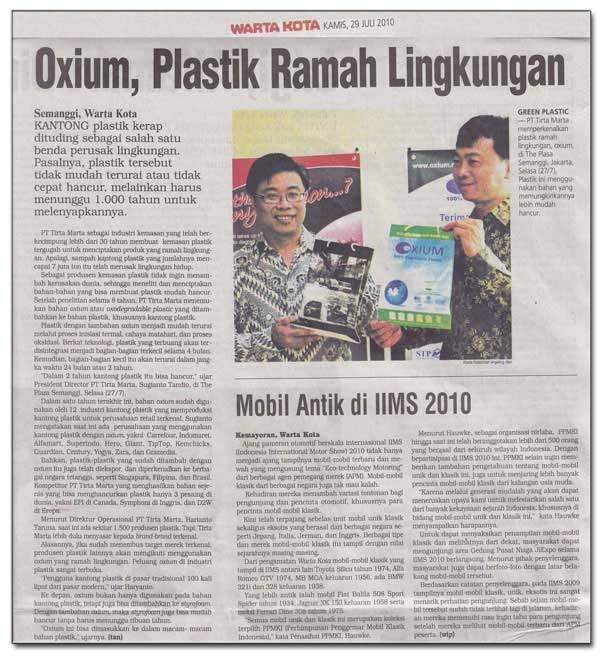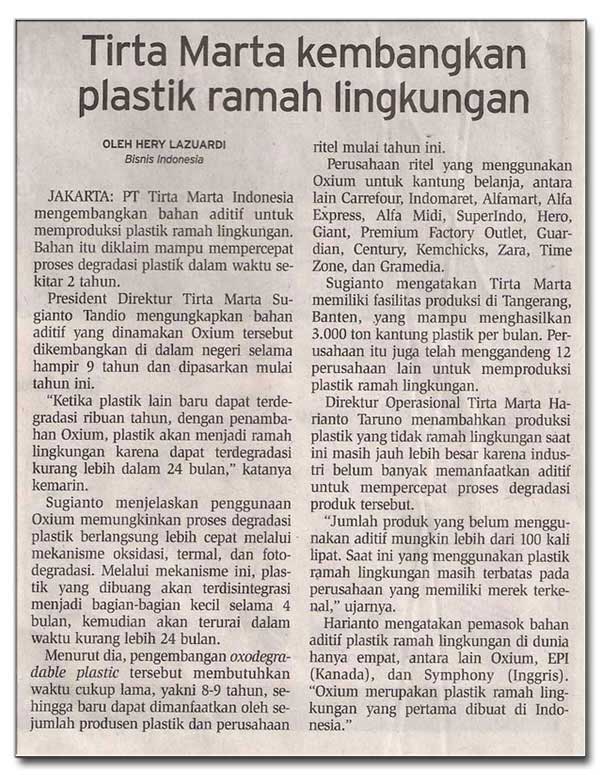Problem masalah sampah plastik telah memicu banyak pihak untuk turut mencari jalan keluarnya. Beberapa produsen mengembangkan ide / teknologi untuk menghasilkan produk yang dapat menekan masalah sampah plastik.
Kita sudah mendengar tentang singkong yang dijadikan bahan baku untuk pembuatan kantong plastik yang dijami dapat terurai. Selain itu ada juga kantong plastik berteknologi Oxium.
Kantong plastik ini dinilai banyak kelebihan, antara lain fungsinya sama dengan kantong kresek konvensional, harganya pun bersaing dengan kantong kresek konvensional, dan berkat teknologi oxium, plastik diklaim dapat terurai lebih cepat dibanding plastik biasa.
Anda mungkin asing dengan “teknologi oxium”, namun kemungkinan besar Anda sudah pernah menggunakan plastik oxium. Plastiknya lebih tipis dibanding kantong plastik biasa dan dipakai di minimarket, supermarket serta restoran besar di Indonesia. Jika Anda perhatikan pada kantong plastiknya tercantum logo Oxium.
Namun di balik semua kelebihan itu, keberadaan oxium masih menjadi perdebatan. Menurut penjelasan Akbar Hanif Dawam Abdullah dari Lembaga Ilmu Pengetahuan Indonesia (LIPI), plastik oxium menyimpan bahaya karena partikel kecil plastik dari oxium bisa masuk ke aliran air, tanah, termakan ikan, dan akhirnya berpindah ke tubuh manusia tanpa disadari.
Partikel kecil dari plastik atau mikroplastik ini dinilai berbahaya buat alam dan manusia. Sociopreneur Sustainable Indonesia juga mengamini hal tersebut. Maka itu Paprika Living memfasilitasi diskusi dengan harapan agar kita semua sebagai konsumen mendapat pencerahan tentang isu ini.
Diskusi menghadirkan Tommy Tjiptadjaja dari Greenhope Indonesia (technology social entreprise yang menciptakan teknologi Oxium), Shivan dari Ecorasa (produk wadah makanan berteknologi Oxium), Nada Arini serta Yuri Rumero dari Sustainable Indonesia, bertempat di Jakarta, September lalu.
Mari kita mulai dengan pemahaman yang benar. Oxium bukan Plastik.
“Oxium bukan plastik melainkan teknologi aditif oxo-biodegradable yang dapat mempercepat degradasi molekul dan kimia plastik sehingga membantu menyelesaikan akumulasi besar problem limbah plastik,” jelas Tommy.
Oxium terbuat dari mineral alam yang tersedia secara alami yang tidak berbahaya bagi tubuh. Teknologi ini terbukti telah terdegradasi melalui proses oxo-biodegradation sebagaimana diuji dan melewati ASTM 6954, memiliki sertifikat SNI Ekolabel, BPOM, dan EU/Japan Food Migration Standard. Teknologi inipun sudah dipatenkan oleh AS.
Sertifikasi keamanan inilah yang membuat Tommy percaya kalau teknologi Oxium aman untuk lingkungan dan makhluk hidup.
Berbeda dengan penjelasan Tommy, tim Sustainable Indonesia tetap menganggap Oxium bukanlah jawaban ataupun solusi untuk masalah plastik Indonesia.
“Selama belum ada tes yang membuktikan kalau plastik Oxium bisa aman walaupun sudah terurai sangat-sangat mikro, oxium bukanlah jawaban untuk masalah sampah plastik,” ujar Nada yang menganjurkan agar semua klaim tersebut dibuktikan dengan uji coba di lapangan, seperti di TPA Bantar Gebang misalnya.
Tommy merepons tanggapan Nada dengan mengatakan sangat sulit untuk melihat apakah yang diproses oleh Oxium tersebut mikroplastik apa bukan. Menurutnya apapun yang sudah bisa diproses oleh mikroba tidak bisa dikatakan sebagai mikroplastik.
Sebagai penyedia produk, Tommy melihat masalah plastik ini cukup problematik karena yang diinginkan orang adalah kondisi yang sangat ideal, yaitu “Mau murah, tapi juga ramah lingkungan, sekaligus kuat dan tahan lama.”
Karenanya, supaya ke depannya lebih baik, butuh komunikasi dan kerja sama semua elemen untuk menemukan solusi yang perfect. “Semua mengaku punya solusi yang lebih baik, tapi kita sebagai penyedia produk bisanya melihat teknologi mana yang lebih baik,” tambah Shivan.
Apakah Plastik berteknologi Oxium adalah pilihan yang lebih baik?
Meski memiliki segala kelebihan, Yuri Romero tampak enggan untuk mengiyakan. Ada kekhawatiran jika sebuah produk dianggap lebih baik, maka orang jadi cenderung menggunakannya tanpa kesadaran karena produk tersebut toh “ramah lingkungan”.
Yuri juga menanggapi, alangkah baiknya bila para pelaku bisnis juga berorientasi kepada sosial, salah satunya adalah dengan tidak hanya memproduksi produk tetapi juga manajemen sampah yang dihasilkan oleh produk tersebut.
“Ecorasa sudah membuat produk yang ramah lingkungan sejauh ini, ketika sampah dibuang sembarangan, tentu ini kembali ke perilaku manusianya, edukasi dan sistem pembuangan sampah di Indonesia yang juga harus dibenahi,” jelas Shivan.
Nah, ingin tahu lebih detail diskusi soal Oxium ini, tonton selengkapnya di link youtube berikut ini:
https://www.youtube.com/watch?v=VgZIupjHvaE
Source: https://www.paprikaliving.com/plastik-berteknologi-oxium-solusi-atau-justru-masalah-baru/












